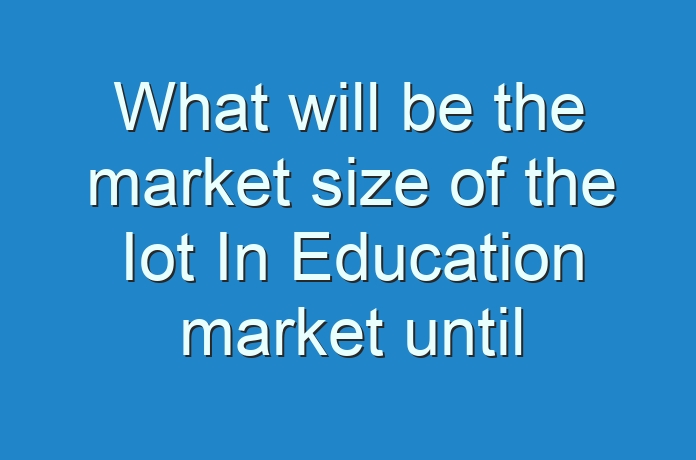
IoT in education market – Overview
Rise in the use of mobile and Internet of Things (IoT)-enabled devices has transformed several industries, including automotive, health care, and retail. However, one of the significant beneficiaries of Internet of Things (IoT) is the education sector. Smart devices have become commonplace in classrooms. Each year, Internet-enabled devices, such as smart boards to tablets, are being introduced in classrooms. IoT-enabled devices provide a number of benefits to educational institutions, which help them function in a more efficient manner. The most important benefit of having a connected classroom is that it streamlines tracking and accountability. Moreover, the cloud allows for easy storage of data related to students’ grades, classwork and homework, and various assignments. In case of higher education, IoT has made gathering, sharing, and presentation of information easy and quick. Colleges and universities are experimenting with IoT approaches. For instance, adoption of fitness devices to keep check on students’ health or tracking temperature readings in lab equipment and sending notifications whenever required.
IoT in education market – Drivers and Restraints
IoT in education creates an entire learning flow, from content creation to publication of large online modules. It also helps in the deployment of an academic LMS in educational institutions that essentially allows instructors to manage course content and monitor and evaluate students’ performance. A lecture capture solution (LCS) is another interactive platform used in educational institutions that records lessons, presentations, and meetings in the digital format for later viewing.
The IoT in education market is driven by the production of digital learning solutions supported by strong connectivity, low-cost devices, and strong government initiatives in different regions to promote the adoption of IoT enabled devices in schools and universities. Digital learning solutions efficiently integrate with one another to allow data to flow seamlessly, thereby allowing institutions to build a comprehensive Big Data repository. Increase in the requirement of students to receive information anytime and anywhere and the need to propagate information have brought IoT enabled solutions to the vanguard of the education sector.
However, the growing vulnerability around the security and privacy of the IoT ecosystem and complications regarding financing information technology infrastructure and services are estimated to restrict the growth of the IoT in education market in the coming years. Nevertheless, increase in the adoption of IoT devices is expected to present a number of opportunities for IoT in education market. Many universities are now using hybrid cloud as their enterprise architecture for hosting different IoT applications. Moreover, there is rise in the use of learning management systems for generating vast data among schools as well as universities. Advance electronic classrooms are now well equipped with lecture capture systems and web streaming that provide material on demand whenever required. IoT also offers a unique opportunity for online digital courses, which helps students to attend courses without being physically present. This has helped students in emerging economies to earn degrees without investing large amounts in higher education. IoT is being used to integrate mobile learning applications. The apps are helping students to take advantage for learning resources, efficiently work on projects, and manage assignments.
Want to gain competitive advantage from our actionable, insightful business intelligence? Request a sample https://www.transparencymarketresearch.com/sample/sample.php?flag=S&rep_id=51474

IoT in education market – Segmentation
The IoT in education market can be segmented based on component, application, and region. Based on component, the IoT in education market can be classified into hardware, software, and services. In terms of application, the IoT in education market can be categorized into learning management solutions, Big Data analytics, academic devices, and lecture capturing solutions. Based on region, the ma IoT in education market rket can be segmented into North America, Europe, Asia Pacific, South America, and Middle East & Africa.
IoT in education market – Key Players
Key players in the IoT in education market include Google Inc. Adobe Systems, Educomp Solution, Intel Corporation, IBM Corporation,TopScan LLC (Scanmarker), IPEVO Inc., SMART Technologies, Sonic Foundry Inc., ARM Ltd., Cisco Systems, Unit4, N2N Services, SunGard K-12, and Ellucian Company L.P.
The report offers a comprehensive evaluation of the market. It does so via in-depth qualitative insights, historical data, and verifiable projections about market size. The projections featured in the report have been derived using proven research methodologies and assumptions. By doing so, the research report serves as a repository of analysis and information for every facet of the market, including but not limited to: Regional markets, technology, types, and applications.
The study is a source of reliable data on:
- Market segments and sub-segments
- Market trends and dynamics
- Supply and demand
- Market size
- Current trends/opportunities/challenges
- Competitive landscape
- Technological breakthroughs
- Value chain and stakeholder analysis
The regional analysis covers:
- North America (U.S. and Canada)
- Latin America (Mexico, Brazil, Peru, Chile, and others)
- Western Europe (Germany, U.K., France, Spain, Italy, Nordic countries, Belgium, Netherlands, and Luxembourg)
- Eastern Europe (Poland and Russia)
- Asia Pacific (China, India, Japan, ASEAN, Australia, and New Zealand)
- Middle East and Africa (GCC, Southern Africa, and North Africa)
The report has been compiled through extensive primary research (through interviews, surveys, and observations of seasoned analysts) and secondary research (which entails reputable paid sources, trade journals, and industry body databases). The report also features a complete qualitative and quantitative assessment by analyzing data gathered from industry analysts and market participants across key points in the industry’s value chain.
A separate analysis of prevailing trends in the parent market, macro- and micro-economic indicators, and regulations and mandates is included under the purview of the study. By doing so, the report projects the attractiveness of each major segment over the forecast period.
Highlights of the report:
- A complete backdrop analysis, which includes an assessment of the parent market
- Important changes in market dynamics
- Market segmentation up to the second or third level
- Historical, current, and projected size of the market from the standpoint of both value and volume
- Reporting and evaluation of recent industry developments
- Market shares and strategies of key players
- Emerging niche segments and regional markets
- An objective assessment of the trajectory of the market
- Recommendations to companies for strengthening their foothold in the market
Looking for exclusive market insights from business experts? Buy Now Report here https://www.transparencymarketresearch.com/checkout.php?rep_id=51474<ype=S
Note: Although care has been taken to maintain the highest levels of accuracy in TMR’s reports, recent market/vendor-specific changes may take time to reflect in the analysis.
This study by TMR is all-encompassing framework of the dynamics of the market. It mainly comprises critical assessment of consumers’ or customers’ journeys, current and emerging avenues, and strategic framework to enable CXOs take effective decisions.
Our key underpinning is the 4-Quadrant Framework EIRS that offers detailed visualization of four elements:
- Customer Experience Maps
- Insights and Tools based on data-driven research
- Actionable Results to meet all the business priorities
- Strategic Frameworks to boost the growth journey
The study strives to evaluate the current and future growth prospects, untapped avenues, factors shaping their revenue potential, and demand and consumption patterns in the global market by breaking it into region-wise assessment.





